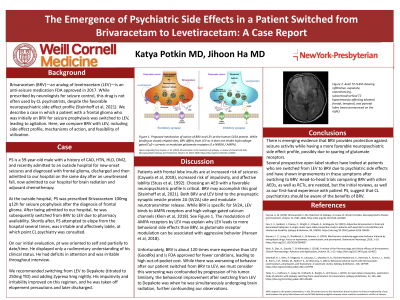Neurocognitive Disorders, Delirium, and Neuropsychiatry
Session: Poster Session
(093) The Emergence of Psychiatric Side Effects in a Patient Switched from Brivaracetam to Levetiracetam

Trainee Involvement: Yes

Katya Potkin, MD
Resident Physician
NYP-Weill Cornell
New York, New York, United States
Jihoon Ha, MD
Psychiatry Attending
New York Presbyterian/Weill Cornell Medical Center
New York, New York, United States
Presenting Author(s)
Co-Author(s)
Background: Brivaracetam (BRV)—an analog of levetiracetam (LEV)—is an anti-seizure medication FDA approved in 2017. While prescribed by neurologists for seizure control, this drug is not often used by CL psychiatrists, despite the favorable neuropsychiatric side effect profile (Steinhoff et al, 2021). We describe a case in which a patient with a frontal glioma who was initially on BRV for seizure prophylaxis was switched to LEV, leading to agitation. Here, we compare BRV with LEV, including side effect profile, mechanisms of action, and feasibility of utilization.
Methods: PS was prescribed Brivaracetam 100mg q12h at an outside hospital for seizure prophylaxis after a diagnosis of frontal glioma. Later, PS presented to our hospital following a fall. He was subsequently switched from BRV to LEV due to pharmacy availability. Shortly after, PS attempted to elope from the hospital, was irritable and affectively labile, at which point CL psychiatry was consulted. We recommended switching from LEV to Depakote (titrated to 250mg TID) and Zyprexa 5mg nightly. His impulsivity and irritability improved on this regimen, and he was taken off elopement precautions and discharged.
Discussion: Patients with frontal lobe insults are at increased risk of seizures (Cayuela et al, 2018), increased risk of impulsivity, and affective lability (Stuss et al, 1992). Choosing an AED with a favorable neuropsychiatric profile is critical. BRV may accomplish this goal (Steinhoff et al, 2021). Both BRV and LEV bind to the presynaptic synaptic vesicle protein 2A (SV2A) site and modulate neurotransmitter release. While BRV is specific for SV2A, LEV binds to AMPA receptors and high-voltage-gated calcium channels (Klein et al, 2018). See Figure 1. The modulation of AMPA receptors by LEV may explain why LEV leads to more behavioral side effects than BRV, as AMPA modulation is associated with aggressive behavior (Hansen et al, 2018).
Unfortunately, BRV is about 120 times more expensive than LEV (GoodRx) and is FDA approved for fewer conditions, leading to high out-of-pocket cost. While there was worsening of behavior after our patient switched from BRV to LEV, we must consider this worsening was confounded by progression of his tumor. Similarly, the behavioral improvement after switching from LEV to Depakote was when he was simultaneously undergoing brain radiation, further confounding our observations.
Conclusions: There is emerging evidence that BRV provides protection against seizure activity while having a more favorable neuropsychiatric side effect profile, possibly due to sparing AMPA receptors. Head-to-head trials comparing BRV with other AEDs is needed, but the initial reviews, as well as our first-hand experience with patient PS, suggest that CL psychiatrists should be aware of the benefits of BRV.
References:
Hansen CC et al. Mechanisms Underlying Aggressive Behavior Induced by Antiepileptic Drugs: Focus on Topiramate, Levetiracetam, and Perampanel. Behav Neurol. 2018 Nov 15;2018:2064027.
Klein P et al. A review of the pharmacology and clinical efficacy of brivaracetam. Clin Pharmacol. 2018 Jan 19;10:1-22.
Steinhoff BJ et al. Behavioral adverse events with brivaracetam, levetiracetam, perampanel, and topiramate: A systematic review. Epilepsy Behav. 2021 May;118:107939. doi: 10.1016/j.yebeh.2021.107939. Epub 2021 Apr 8. PMID: 33839453.

